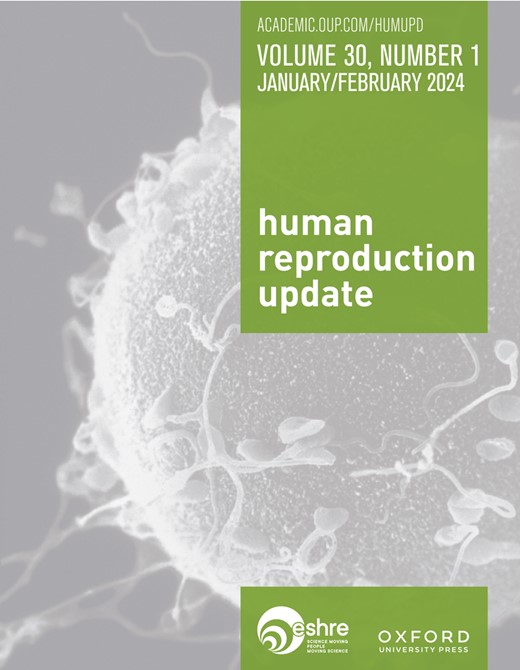走向全能性:全能性和幼稚多能干细胞的分子和细胞特征。
IF 16.1
1区 医学
Q1 OBSTETRICS & GYNECOLOGY
引用次数: 0
摘要
解剖胚胎发育的关键分子机制为胚胎发生和临床实践提供了新的见解和潜在的干预策略。然而,研究人类早期胚胎发育的分子机制的能力,如合子基因组激活和谱系分离,受到方法限制和伦理问题的有意义的限制。全能干细胞具有向胚胎和胚胎外组织分化的广泛发育潜力,为研究早期胚胎发育提供了合适的模型。近年来,在干细胞方面取得了一系列突破性的成果,已经鉴定出了全能样细胞或诱导多能干细胞向全能样细胞的转变。目的和理由本综述遵循PRISMA指南,综述了目前关于多能干细胞、原始多能干细胞和成形性多能干细胞的文献,介绍了这些干细胞的分子和生物学特性,并对未来的研究提出了建议。在PubMed、Web of Science和Cochrane Library中,使用“全能性”或“幼稚多能干细胞”或“形成性多能干细胞”进行未经过滤的搜索。纳入的论文包括到2024年6月以英语发表的关于全能干细胞、幼稚多能干细胞或形成性多能干细胞的信息。与干细胞、全能性、幼稚多能性或成形性多能性细胞无关的文章被排除在外。结果:本综述纳入了152例记录。这些出版物根据研究中包含的细胞种类分为四组:67项人类干细胞研究,70项小鼠干细胞研究,9项猪干细胞研究和6项食蟹干细胞研究。幼稚多能干细胞模型已经在其他物种如猪和食蟹中建立。人类和小鼠的全能干细胞,如人类8细胞样细胞、人类全能卵裂球样细胞和小鼠2细胞样细胞,已经成功建立,并在胚胎和胚胎外贡献中表现出很高的发育潜力。然而,观察到的这些细胞与真实胚胎在表观遗传学和转录方面的差异表明,进一步的研究是有必要的。我们的研究结果系统地回顾了不同的原始干细胞、形成多能干细胞和全能干细胞的建立方法、分子特征和发育潜能。此外,我们提供了动物和人类模型的平行比较,并对未来的应用提出了建议,以推进早期胚胎研究和辅助生殖技术。多能细胞模型为理解胚胎发育的潜在机制提供了宝贵的资源,并为未来治疗不孕症和再生医学开辟了新的途径。然而,目前的体外细胞模型表现出与体内胚胎的表观遗传和转录差异,并且许多细胞模型在传代过程中不稳定,因此不能完美地再现胚胎发育。在这方面,规范和扩大目前对全能干细胞模型的研究对于提高我们模拟和破译胚胎发生的能力至关重要。本文章由计算机程序翻译,如有差异,请以英文原文为准。
Moving toward totipotency: the molecular and cellular features of totipotent and naive pluripotent stem cells.
BACKGROUND
Dissecting the key molecular mechanism of embryonic development provides novel insights into embryogenesis and potential intervention strategies for clinical practices. However, the ability to study the molecular mechanisms of early embryo development in humans, such as zygotic genome activation and lineage segregation, is meaningfully constrained by methodological limitations and ethical concerns. Totipotent stem cells have an extended developmental potential to differentiate into embryonic and extraembryonic tissues, providing a suitable model for studying early embryo development. Recently, a series of ground-breaking results on stem cells have identified totipotent-like cells or induced pluripotent stem cells into totipotent-like cells.
OBJECTIVE AND RATIONALE
This review followed the PRISMA guidelines, surveys the current works of literature on totipotent, naive, and formative pluripotent stem cells, introduces the molecular and biological characteristics of those stem cells, and gives advice for future research.
SEARCH METHODS
The search method employed the terms 'totipotent' OR 'naive pluripotent stem cell' OR 'formative pluripotent stem cell' for unfiltered search on PubMed, Web of Science, and Cochrane Library. Papers included were those with information on totipotent stem cells, naive pluripotent stem cells, or formative pluripotent stem cells until June 2024 and were published in the English language. Articles that have no relevance to stem cells, or totipotent, naive pluripotent, or formative pluripotent cells were excluded.
OUTCOMES
There were 152 records included in this review. These publications were divided into four groups according to the species of the cells included in the studies: 67 human stem cell studies, 70 mouse stem cell studies, 9 porcine stem cell studies, and 6 cynomolgus stem cell studies. Naive pluripotent stem cell models have been established in other species such as porcine and cynomolgus. Human and mouse totipotent stem cells, e.g. human 8-cell-like cells, human totipotent blastomere-like cells, and mouse 2-cell-like cells, have been successfully established and exhibit high developmental potency for both embryonic and extraembryonic contributions. However, the observed discrepancies between these cells and real embryos in terms of epigenetics and transcription suggest that further research is warranted. Our results systematically reviewed the established methods, molecular characteristics, and developmental potency of different naive, formative pluripotent, and totipotent stem cells. Furthermore, we provide a parallel comparison between animal and human models, and offer recommendations for future applications to advance early embryo research and assisted reproduction technologies.
WIDER IMPLICATIONS
Totipotent cell models provide a valuable resource to understand the underlying mechanisms of embryo development and forge new paths toward future treatment of infertility and regenerative medicine. However, current in vitro cell models exhibit epigenetic and transcriptional differences from in vivo embryos, and many cell models are unstable across passages, thus imperfectly recapitulating embryonic development. In this regard, standardizing and expanding current research on totipotent stem cell models are essential to enhance our capability to resemble and decipher embryogenesis.
求助全文
通过发布文献求助,成功后即可免费获取论文全文。
去求助
来源期刊

Human Reproduction Update
医学-妇产科学
CiteScore
28.80
自引率
1.50%
发文量
38
期刊介绍:
Human Reproduction Update is the leading journal in its field, boasting a Journal Impact FactorTM of 13.3 and ranked first in Obstetrics & Gynecology and Reproductive Biology (Source: Journal Citation ReportsTM from Clarivate, 2023). It specializes in publishing comprehensive and systematic review articles covering various aspects of human reproductive physiology and medicine.
The journal prioritizes basic, transitional, and clinical topics related to reproduction, encompassing areas such as andrology, embryology, infertility, gynaecology, pregnancy, reproductive endocrinology, reproductive epidemiology, reproductive genetics, reproductive immunology, and reproductive oncology. Human Reproduction Update is published on behalf of the European Society of Human Reproduction and Embryology (ESHRE), maintaining the highest scientific and editorial standards.
 求助内容:
求助内容: 应助结果提醒方式:
应助结果提醒方式:


